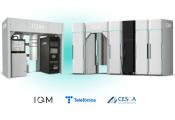Riverlane Releases New Report To Accelerate Industry Through the ‘QEC Era’
October 22, 2024 -- Riverlane, the global leader in quantum error correction technology, in partnership with Resonance, today released the first-of-its-kind Quantum Error Correction Report 2024. Highlighting critical insights and trends that will aid the quantum industry’s navigation through its newest phase, the ‘QEC era,’ the report marks the pivotal steps needed to advance quantum computing from the experimental stages to real-world applications.
Transitioning beyond the noisy intermediate-scale quantum (NISQ) era and scaling quantum hardware to enable transformative applications will require quantum error correction. The Quantum Error Correction Report 2024 delivers an understanding of the current state of QEC development and the opportunities and challenges ahead. This comprehensive guide draws on public data from 29 hardware companies, including interviews with 12 global industry experts from companies such as Amazon Web Services (AWS), Rigetti Computing, IQM, IonQ, and Alice & Bob.
“Solving quantum error correction is no longer a distant goal—it has become the fundamental cornerstone of quantum computing, and its implementation is rapidly expanding across the industry”, said Steve Brierley, Founder and CEO of Riverlane. “Recent developments in quantum error correction, combined with continued device improvements, have unlocked the next generation of quantum computers that will surpass classical computers within the next 5 years”.
Key Insights from the QEC Report 2024:
1. The QEC era is here
In 2024, QEC gained significant momentum as big tech, governments, and quantum companies came together to affirm its crucial role. From research to roadmaps to funding strategies, the quantum computing community and its stakeholders united in pursuing quantum error correction.
The Quantum Error Correction Report highlights the arrival and prevalence of the QEC era, noting:
Major research breakthroughs in the last year from companies such as Google, AWS, IBM and Microsoft and Quantinuum have shown that QEC is now achievable across all major qubit types.
Every quantum hardware company roadmap released in the last 12 months included QEC, demonstrating that every hardware company needs QEC capability by 2028.
Of the 29 quantum hardware companies profiled, the majority (66 %) are actively implementing or heavily focused on QEC, and half collaborate with external third parties on their implementations.
Every quantum company profiled cited qubit fidelity, or accuracy, as the leading QEC challenge.
2. Surpassing the supercomputing threshold is the next important, near-term goal
Achieving one million error-free quantum operations (MegaQuOp) marks a pivotal moment when quantum computers surpass the capabilities of any classical supercomputer. The quantum community is aiming for this next landmark goal, confident that QEC will achieve the MegaQuOp within two to three years. As quantum computers enter and then move beyond the MegaQuOp regime, the range and complexity of quantum applications will increase. The report details three early use cases, which will be achieved at the MegaQuOp.
3. The QEC era will reveal new challenges
The quantum industry has made significant progress in QEC, but many engineering challenges remain. To implement QEC effectively, quantum hardware companies must develop qubits with physical error rates below the "QEC threshold" and achieve sufficient scale (number of physical qubits. Once qubits reach a 99.9% QEC threshold, companies will need to introduce an additional set of classical QEC technologies to manage the massive, real-time data processing that follows.
Other challenges include improving QEC codes to reduce the “QEC overhead” and integrating QEC with quantum control systems. Along with the difficulty of scaling and stabilising quantum systems, the ongoing process of engineering a dedicated "QEC stack" is a complex undertaking.
"We can't overstate the recent progress the quantum computing industry has made. Five years ago, we did not believe the experiments realised in the last 12 months were possible," said Earl Campbell, VP of Quantum Science at Riverlane. "But now, we're at this exciting stage where we know that QEC works in practice. While some difficult engineering challenges remain, entering the QEC era means there's now little doubt that quantum computing will become a reality."
4. A new era calls for new metrics
Entering the QEC era has major implications. As quantum computing advances beyond previous generations, current performance metrics may no longer be adequate for comparing performance or capturing the complexities of increasingly fault-tolerant systems. Future quantum technologies will need new metrics and, possibly, application-specific benchmarks.
“The Quantum Error Correction Report exemplifies the advancements made by the quantum computing industry. The expert perspectives shared within the report are a testament to the value of collaboration and the quantum computing industry's collective efforts. The insights emphasize the importance of continued development, not just for addressing technical challenges but for supporting the broader potential of quantum computing,” said Alex Challans, CEO of Resonance and The Quantum Insider.




































